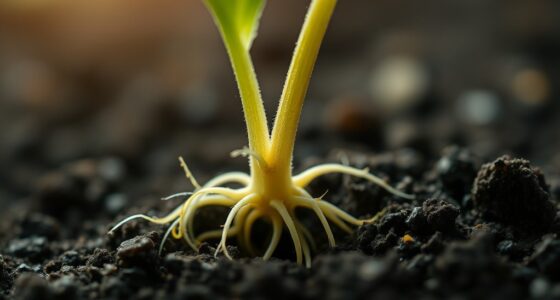Synthetic growth regulators can boost crop yields and promote uniform development, but they also carry risks like environmental contamination and harm to beneficial organisms. You need to weigh the benefits of increased productivity and better crop control against potential ecological and health hazards. Proper application, regulation, and adherence to guidelines are essential to minimize risks. If you want to understand how to maximize these tools safely, there’s more you should consider.
Key Takeaways
- Synthetic growth regulators boost crop yields and uniformity but may cause abnormal growth and unintended morphological changes.
- They mimic or disrupt natural hormones, influencing development but risking ecological imbalance and harm to beneficial organisms.
- Proper regulation, dosage, and timing are crucial to maximize benefits and minimize environmental and biological risks.
- Long-term environmental impacts include soil and water contamination, affecting ecosystems and biodiversity.
- Responsible use involves ongoing research, adherence to guidelines, and balancing agricultural productivity with ecological safety.

Have you ever wondered how farmers control plant growth and improve crop yields? They often turn to synthetic growth regulators, which are chemical substances designed to influence plant development. These regulators mimic or interfere with the plant’s natural hormones, allowing farmers to direct growth patterns, enhance fruit production, or delay aging. By applying these chemicals, crops can grow more uniformly, resist environmental stresses, and reach harvest stages faster. However, their use isn’t without concerns, especially surrounding hormonal interference and environmental impact.
Synthetic growth regulators work by disrupting or mimicking the plant’s natural hormonal balance. For example, auxin-like chemicals promote root development or stimulate fruit growth, while gibberellin-like compounds can induce taller plants or larger fruits. While these effects can be beneficial, they also risk hormonal interference that might upset the plant’s natural processes. Such interference can lead to abnormal growth, reduced resilience, or unintended morphological changes. It’s essential for farmers to use these regulators carefully, adhering to recommended dosages and application timings to avoid damaging the plants or causing unpredictable growth patterns.
Beyond influencing plant physiology, synthetic growth regulators raise questions about their environmental impact. When applied in large quantities or improperly, these chemicals can leach into the soil, water sources, or surrounding ecosystems. This contamination can harm beneficial insects, aquatic life, and even soil microorganisms vital for healthy agriculture. Over time, persistent chemicals may accumulate, leading to long-term ecological imbalances. Furthermore, runoff can affect nearby crops or natural habitats, creating a ripple effect that extends well beyond the intended target.
While synthetic growth regulators can boost productivity and help meet global food demands, their potential to cause hormonal disruptions within plants and damage ecosystems makes their use a double-edged sword. Proper regulation and responsible application are essential to harness their benefits while minimizing risks. Farmers and agronomists need to stay informed about the latest research and guidelines to guarantee these chemicals are used safely and effectively. As with many agricultural tools, the key lies in balancing the immediate advantages of improved crop yields with the broader responsibility of safeguarding environmental health. Ultimately, understanding the complex interactions between these chemicals, plant biology, and ecosystems can help you make more informed decisions about their role in modern farming.
Frequently Asked Questions
Are Synthetic Growth Regulators Environmentally Sustainable?
Synthetic growth regulators aren’t entirely environmentally sustainable, but their impact depends on how you use them. If you follow sustainable practices, such as proper application timing and dosage, you can minimize environmental impact. However, overuse or misuse can harm ecosystems, so it is crucial to weigh the benefits against potential risks. By adopting responsible methods, you help balance crop benefits with environmental health, making their use more sustainable overall.
How Do Synthetic Regulators Affect Non-Target Plant Species?
Synthetic regulators can cause unintended non-target effects, disrupting native plant diversity and delicate ecological balances. You might notice these chemicals influencing neighboring plants, sometimes leading to stunted growth or unexpected flowering. Such ecological impacts can threaten local biodiversity and disturb ecosystems. By understanding these risks, you can better assess how synthetic growth regulators affect non-target plant species and work to minimize harmful environmental consequences.
Can Synthetic Growth Regulators Cause Long-Term Soil Health Issues?
Synthetic growth regulators can cause long-term soil health issues by disrupting soil microbial activity and increasing residual soil toxicity. You might notice that these chemicals alter the balance of beneficial microbes, which are essential for nutrient cycling and soil fertility. Over time, residual toxicity can accumulate, harming plants and soil organisms, and potentially reducing crop yields and soil resilience. It’s important to monitor their use carefully to minimize long-term impacts.
Are There Natural Alternatives to Synthetic Growth Regulators?
Think of natural solutions as the roots of a healthy plant—you can’t see them, but they support everything. You can explore organic alternatives and plant-based solutions to manage growth without synthetic chemicals. These natural methods help promote sustainable farming, reduce chemical dependency, and protect soil health. By choosing organic options, you’re nurturing your crops and the environment, ensuring a balanced approach that benefits both now and in the future.
What Are the Regulations Governing Synthetic Growth Regulator Use?
You need to understand that regulations governing synthetic growth regulator use focus on regulatory compliance and usage restrictions. These laws vary by country, requiring you to adhere to specific application limits, safety protocols, and licensing standards. Always check local regulations before using these chemicals, as improper use can lead to legal penalties or crop damage. Staying informed helps you balance benefits with risks while ensuring safe and compliant practices.
Conclusion
Synthetic growth regulators can boost crop yields and improve quality, but they also carry potential risks if misused. Imagine a farmer who overapplies these chemicals, leading to stunted plant growth and environmental harm. To enjoy their benefits responsibly, stay informed and follow recommended guidelines. Balancing innovation with caution guarantees you maximize gains without compromising safety or sustainability. Ultimately, responsible use helps you achieve healthy, productive crops while protecting the environment for future generations.









